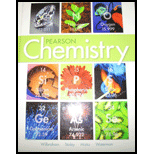
Chemistry 2012 Student Edition (hard Cover) Grade 11
12th Edition
ISBN: 9780132525763
Author: Prentice Hall
Publisher: Prentice Hall
expand_more
expand_more
format_list_bulleted
Question
Chapter 2.2, Problem 18LC
Interpretation Introduction
Interpretation: The procedure that is used to separate a mixture of sand and table salt should be described.
Concept Introduction: A property that is a characteristic of matter and not associated with any change in chemical composition is said to be physical property.
Expert Solution & Answer
Answer to Problem 18LC
To separate a mixture of sand and table salt filtration is used.
Explanation of Solution
The differences in physical properties like phase, boiling point, freezing point, particle size, solubility so on are used to separate mixtures.A mixture of sand and table salt is a heterogenous mixture as the composition in the entire mixture is not uniform throughout; so, filtration is used to separate a mixture of sand and table salt.
Chapter 2 Solutions
Chemistry 2012 Student Edition (hard Cover) Grade 11
Ch. 2.1 - Prob. 1LCCh. 2.1 - Prob. 2LCCh. 2.1 - Prob. 3LCCh. 2.1 - Prob. 4LCCh. 2.1 - Prob. 5LCCh. 2.1 - Prob. 6LCCh. 2.1 - Prob. 7LCCh. 2.1 - Prob. 8LCCh. 2.1 - Prob. 9LCCh. 2.1 - Prob. 10SP
Ch. 2.1 - Prob. 11SPCh. 2.2 - Prob. 12LCCh. 2.2 - Prob. 13LCCh. 2.2 - Prob. 14LCCh. 2.2 - Prob. 15LCCh. 2.2 - Prob. 16LCCh. 2.2 - Prob. 17LCCh. 2.2 - Prob. 18LCCh. 2.2 - Prob. 19LCCh. 2.3 - Prob. 20SPCh. 2.3 - Prob. 21SPCh. 2.3 - Prob. 22LCCh. 2.3 - Prob. 23LCCh. 2.3 - Prob. 24LCCh. 2.3 - Prob. 25LCCh. 2.3 - Prob. 26LCCh. 2.3 - Prob. 27LCCh. 2.3 - Prob. 28LCCh. 2.3 - Prob. 29LCCh. 2.3 - Prob. 30LCCh. 2.3 - Prob. 31LCCh. 2.4 - Prob. 32LCCh. 2.4 - Prob. 33LCCh. 2.4 - Prob. 34LCCh. 2.4 - Prob. 35LCCh. 2.4 - Prob. 36LCCh. 2.4 - Prob. 37LCCh. 2.4 - Prob. 38LCCh. 2 - Prob. 39ACh. 2 - Prob. 40ACh. 2 - Prob. 41ACh. 2 - Prob. 42ACh. 2 - Prob. 43ACh. 2 - Prob. 44ACh. 2 - Prob. 45ACh. 2 - Prob. 46ACh. 2 - Prob. 47ACh. 2 - Prob. 48ACh. 2 - Prob. 49ACh. 2 - Prob. 50ACh. 2 - Prob. 51ACh. 2 - Prob. 52ACh. 2 - Prob. 53ACh. 2 - Prob. 54ACh. 2 - Prob. 55ACh. 2 - Prob. 56ACh. 2 - Prob. 57ACh. 2 - Prob. 58ACh. 2 - Prob. 59ACh. 2 - Prob. 60ACh. 2 - Prob. 61ACh. 2 - Prob. 62ACh. 2 - Prob. 63ACh. 2 - Prob. 64ACh. 2 - Prob. 65ACh. 2 - Prob. 66ACh. 2 - Prob. 67ACh. 2 - Prob. 68ACh. 2 - Prob. 69ACh. 2 - Prob. 70ACh. 2 - Prob. 71ACh. 2 - Prob. 72ACh. 2 - Prob. 73ACh. 2 - Prob. 74ACh. 2 - Prob. 75ACh. 2 - Prob. 76ACh. 2 - Prob. 77ACh. 2 - Prob. 78ACh. 2 - Prob. 79ACh. 2 - Prob. 80ACh. 2 - Prob. 81ACh. 2 - Prob. 82ACh. 2 - Prob. 83ACh. 2 - Prob. 84ACh. 2 - Prob. 85ACh. 2 - Prob. 86ACh. 2 - Prob. 87ACh. 2 - Prob. 88ACh. 2 - Prob. 89ACh. 2 - Prob. 90ACh. 2 - Prob. 93ACh. 2 - Prob. 94ACh. 2 - Prob. 95ACh. 2 - Prob. 1STPCh. 2 - Prob. 2STPCh. 2 - Prob. 3STPCh. 2 - Prob. 4STPCh. 2 - Prob. 5STPCh. 2 - Prob. 6STPCh. 2 - Prob. 7STPCh. 2 - Prob. 8STPCh. 2 - Prob. 9STPCh. 2 - Prob. 10STPCh. 2 - Prob. 11STPCh. 2 - Prob. 12STPCh. 2 - Prob. 13STPCh. 2 - Prob. 14STP
Knowledge Booster
Similar questions
- Please help me figure out the mechanism with arrows of the following reactionarrow_forwardOrganic Functional Groups Predicting the reactants or products of acetal hydrolysis termine the structures of the missing organic molecules in the following reaction: H* H* + H₂O Y ☑ Note: Molecules that share the same letter have the exact same structure. In the drawing area below, draw the skeletal ("line") structures of the missing organic molecules X, Y, and Z. You may draw that you like, so long as they aren't touching. Molecule X shows up in multiple steps, but you only have to draw its structure Explanation Check @2 W Click and drag to start drawing a structure. #4 # 3 LU E % 67 olo 5 66 R T Y & 7 AcGraw Hill LLC. All Rights R Xarrow_forward8. (16 pts) Provide the stepwise mechanism for the synthesis of the following compound via an enaminearrow_forward
arrow_back_ios
SEE MORE QUESTIONS
arrow_forward_ios
Recommended textbooks for you
 ChemistryChemistryISBN:9781305957404Author:Steven S. Zumdahl, Susan A. Zumdahl, Donald J. DeCostePublisher:Cengage Learning
ChemistryChemistryISBN:9781305957404Author:Steven S. Zumdahl, Susan A. Zumdahl, Donald J. DeCostePublisher:Cengage Learning ChemistryChemistryISBN:9781259911156Author:Raymond Chang Dr., Jason Overby ProfessorPublisher:McGraw-Hill Education
ChemistryChemistryISBN:9781259911156Author:Raymond Chang Dr., Jason Overby ProfessorPublisher:McGraw-Hill Education Principles of Instrumental AnalysisChemistryISBN:9781305577213Author:Douglas A. Skoog, F. James Holler, Stanley R. CrouchPublisher:Cengage Learning
Principles of Instrumental AnalysisChemistryISBN:9781305577213Author:Douglas A. Skoog, F. James Holler, Stanley R. CrouchPublisher:Cengage Learning Organic ChemistryChemistryISBN:9780078021558Author:Janice Gorzynski Smith Dr.Publisher:McGraw-Hill Education
Organic ChemistryChemistryISBN:9780078021558Author:Janice Gorzynski Smith Dr.Publisher:McGraw-Hill Education Chemistry: Principles and ReactionsChemistryISBN:9781305079373Author:William L. Masterton, Cecile N. HurleyPublisher:Cengage Learning
Chemistry: Principles and ReactionsChemistryISBN:9781305079373Author:William L. Masterton, Cecile N. HurleyPublisher:Cengage Learning Elementary Principles of Chemical Processes, Bind...ChemistryISBN:9781118431221Author:Richard M. Felder, Ronald W. Rousseau, Lisa G. BullardPublisher:WILEY
Elementary Principles of Chemical Processes, Bind...ChemistryISBN:9781118431221Author:Richard M. Felder, Ronald W. Rousseau, Lisa G. BullardPublisher:WILEY

Chemistry
Chemistry
ISBN:9781305957404
Author:Steven S. Zumdahl, Susan A. Zumdahl, Donald J. DeCoste
Publisher:Cengage Learning

Chemistry
Chemistry
ISBN:9781259911156
Author:Raymond Chang Dr., Jason Overby Professor
Publisher:McGraw-Hill Education

Principles of Instrumental Analysis
Chemistry
ISBN:9781305577213
Author:Douglas A. Skoog, F. James Holler, Stanley R. Crouch
Publisher:Cengage Learning

Organic Chemistry
Chemistry
ISBN:9780078021558
Author:Janice Gorzynski Smith Dr.
Publisher:McGraw-Hill Education

Chemistry: Principles and Reactions
Chemistry
ISBN:9781305079373
Author:William L. Masterton, Cecile N. Hurley
Publisher:Cengage Learning

Elementary Principles of Chemical Processes, Bind...
Chemistry
ISBN:9781118431221
Author:Richard M. Felder, Ronald W. Rousseau, Lisa G. Bullard
Publisher:WILEY